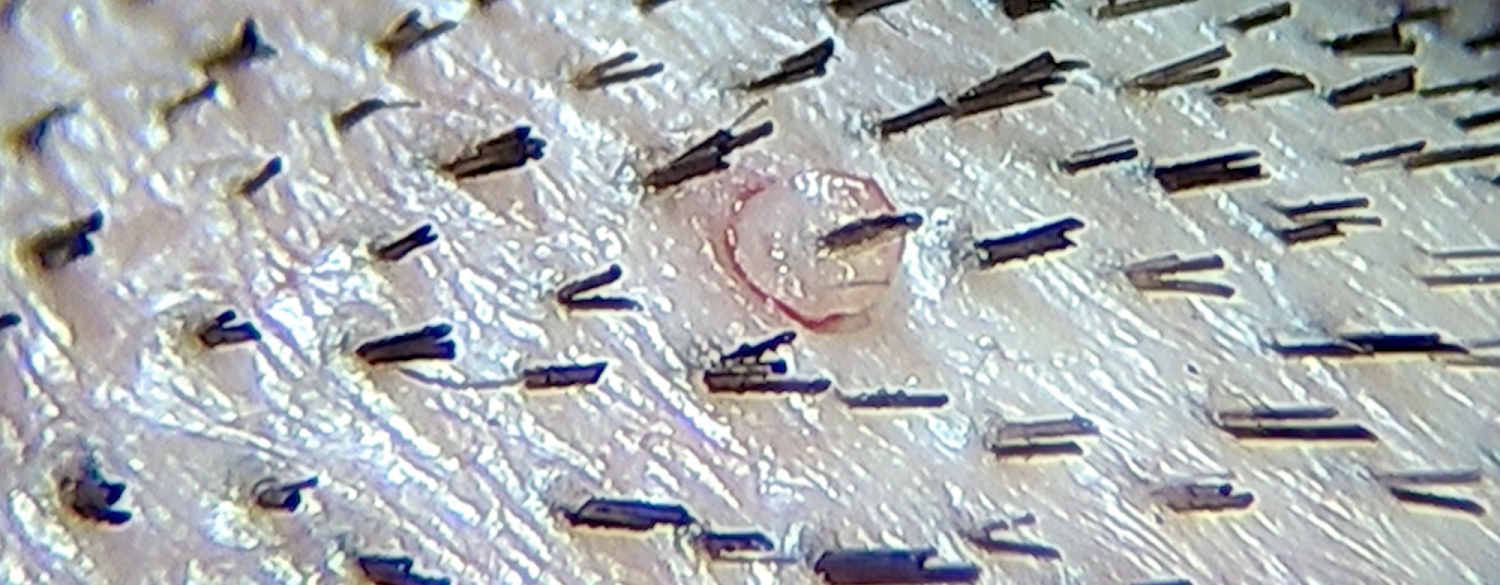FUE Technique


FUE Technique
In recent years there have been many improvements in hair transplant procedures. FUE (Follicular Unit Excision) has become the benchmark procedure ahead of FUT (strip procedure). The robotization that appeared in France in 2014 has continued to improve and the latest version IX of the Artas robot is much more efficient than the previous ones.
Finally, shave-free procedures have emerged as well as long hair transplants (Long Hair FUE). All of this explained on this informative hair transplant site.
What is a follicular unit? It is the bunch of hair that comes out through the same skin pore; there may be 1,2,3 or 4 hairs, or even possibly more. The follicular unit is also referred to as a graft or graft in English scientific literature.
The process of FUE harvesting is tricky for several reasons:
- It is impossible to see under the skin
- The hair sometimes diverges, the further under the skin it goes,
- The punch is narrow
- The axis of the hair shaft changes under the skin due to the traction of the hair erector muscle
- The path of the follicle under the skin can be very winding (frizzy hair)
- However, even in these more difficult conditions due to the nature of curly hair, we are able to perform FUE perfectly and successfully. It goes without saying that it is imperative to harvest grafts with optical means which allow high magnification.
The goal is to obtain the best quality of grafts in order to have the maximum regrowth rate; for this the graft must contain the hair shaft but also the tissues located around because they contain the stem cells that will reproduce the hair cycles ("chubby" graft); this can only be verified by microscopic examination.

Microscopic examination of grafts
It is also necessary to avoid damaging the neighbouring follicular units, those that are not removed so that the hair grows back on the sampling area and that round white scars are not noticeable, giving the donor area a “patchy” appearance. For this reason, we do not practice a technique called maxi 3D, which consists of harvesting with punches of 2mm in diameter or more, making the manoeuvre easier but results in of a patchy appearance of the donor area.
The FUE challenge today is to use smaller punches that both deliver good grafts and don't damage unharvested hair.
This scoring process can be performed with manual punches, with micro-motors, and also with the ARTAS robot.

View of a donor area

Follicular units viewed under a microscope (frizzy hair)

Follicular units extraction
FUE hair transplant: A THREE-STAGE OPERATION
This FUE procedure leaves no visible scar and is painless. Using magnifying glasses, the operator removes the grafts one by one, which will be implanted on the areas devoid of hair.
The FUE hair transplant is divided into three operating stages: first of all, hair grafts are harvested.
Secondly, each individual graft is checked under a microscope and finally the grafts are implanted in the recipient area.
Harvesting of grafts
The medical team uses micro-punches to harvest the grafts, carried out on the donor area located on the back of the head (occipital area). In other words, it is the scoring of the scalp using a micro-punch which can be either manual, motorized or robotic.
Today, we use the smallest punches that both harvest quality grafts and avoid damaging neighbouring hair to allow good regrowth in the harvest area.
In our centre, the size of the punches varies from 0.8 to 1.0 mm eternal diameter, which corresponds to internal diameter of 0.5 to 0.7 mm.
It is a manoeuvre that requires a high level of skill (dexterity and experience). This involves freeing the follicular unit from its skin and fatty attachments and extracting it while preserving its integrity. The thickness of these grafts being 0.5 mm, a gentle hand is essential. This can only be learned with daily training.
As with scoring, extraction requires great care.
This procedure is easier for straight hair than for curly hair, which requires a good experience of FUE.
In the presence of an insufficient donor area on the head, grafts can be taken from the body (body hairs) and / or from the beard. It’s also painless.
Of course, body hairs do not have the same texture as head hairs, but when mixed with head hair they are not noticeable and improve the density of the treated area without depleting the donor area too much.
Conditioning
The extracted grafts are all checked under a microscope in order to verify their integrity and to count the number of hairs per graft. This verification is systematic for each procedure, hence the need for a large team.
This is an essential step, and we only implant perfect grafts resulting in a very high regrowth rate; it is also the only way to know precisely the rate of transection (graft lesions during harvesting) achieved during harvesting. Without this verification we cannot know the rate of transection and therefore the figures sometimes put forward are far-fetched.
After inspecting them under a microscope, the grafts are then placed in a compartmentalized cup, (which makes it possible to separate the grafts of 1, 2, 3 and 4 hairs) where the temperature oscillates between 2 and 6 degrees Celsius, until they are reimplanted in the donor area.

Grafts being kept refrigerated

Compartmentalized cup containing grafts of 1,2,3 or 4 hairs
Preparation of the recipient area and implantation of the grafts
As with the harvesting of grafts, several techniques are possible: it often depends on the practices of each medical team.
Implantation methods: 2 OPPOSING TECHNIQUES: micro-tweezers or implanters
METHOD 1
Using a sapphire micro-blade, small skin incisions are made on the area devoid of hair, in which the grafts will be introduced with micro-tweezers, or and this is more recent, with small tubes in which the grafts are previously placed (dull implanter).

A graft being inserted into an implanter
METHOD 2
This manoeuvre can also be performed at the same time as the introduction of the graft using a specific instrument: a sharp implanter. These are small needles equipped with a central valve which allows the graft to be pushed out once the needle is inserted into the scalp. In this way, everything is done in one step.
The experience and dexterity of the operator are critical to ensuring that graft density and orientation is performed correctly.
This method, initially described by a Korean doctor, Doctor CHOI in the 90s, is carried out by many teams around the world: it is our technique of choice because it reduces the handling of grafts and reduces the risk of lesions during the procedure. It also helps to tighten the grafts and obtain a better density per cm / 2.

Graft harvesting
What density should be recreated?
The cumulative thickness index of the hair leads us to appreciate the importance of hair coverage.
This index must be as high as possible.
This value makes it possible to modulate the number of grafts to be transplanted and varies with the expectations of the patients and the criteria of their donor area (density, hair thickness, number of hairs per graft). Simply put, the finer the hair, the more hair is needed, and the smaller number of hairs / grafts means that more grafts are needed.
In our centre the necessary density on the recipient area is evaluated before the procedure and modulated with the patient's expectations.
This requires a very precise measurement of the donor area that only analysis software such as TRANSPLANNER tricholab allows.
It also allows the measurement of the recipient area and allows to calculate the number of grafts needed.
A SPECIFIC POINT: THE HAIRLINE
Its outline depends of course on your sex (the shape is different in men and women) but also on the shape of your face, certain ethnic factors, on your age, the foreseeable evolution of alopecia and the capacities of the donor area.
This outline is not linear but marked with irregularities giving a natural appearance when it regrows.
Particular attention must be paid to the frontotemporal junction and the angle of implantation of the grafts.

Reconstruction of a natural hairline using sharp implanters
After an FUE hair transplant
A light bandage is applied at the end of the operation. The patient should wash their hair gently the next day. The scabs will gradually disappear in about ten days. The hair in the grafts usually starts to fall out after the 15th day: this is completely normal. Regrowth begins in the second postoperative month. A first evaluation is carried out 4 to 6 months after the intervention. The final result can only be seen after 12 months. Exercising and sport can be considered 10 or 11 days after the operation.
The experience of the whole team determines to a large extent the success of the transplant.
Sometimes (10% of cases), oedema (swelling) occurs on the eyes around the 3rd or 4th postoperative day. It is not serious, and it disappears spontaneously within 48 hours.
The benefits of FUE
This operation helps to restore volume to thinning hair but is also suitable for those who suffer from advanced alopecia, with the regrowth having the advantage of offering a very natural appearance. This technique dramatically reduces the level of visible scaring compared to that in FUT (no linear scar on the back of the head). It is also almost painless, less invasive, unlike FUT (no pain in the days following the transplant).
It allows body hair to be used.
It has become the go-to procedure around the world.

Manual punch
MOTORIZED FUE
The punch is still guided by the operator's hand, but the harvest is faster than the manual or robotic technique (1500 to 2500 grafts / hour).
Many motors are available, some of which reproduce the work of the human hand by performing oscillations.
In our team, the transection rates are very low, less than 3% on average over the year. With these technologies, the quality of the grafts is excellent with easier extraction. Many models of punches are usable: sharp, blunt or hybrid; the latter has further improved graft quality.

Motorized punch
TYPE OF ANESTHESIA: local
AVERAGE DURATION OF THE PROCEDURE: it depends on the number of grafts (maximum 3000 grafts in a day)
DONOR AREA: occipital, parietal or temporal
SHAVING LENGTH: 1 mm
RESUMPTION OF SOCIAL ACTIVITY: 10 days
RESUMPTION OF SPORTING ACTIVITY: after 10 days
Please note that the NHT center is closed from August 4 until August 24 inclusive.
An answer will therefore be provided to you by a doctor from the center as soon as it reopens.
NHT EUROPE


